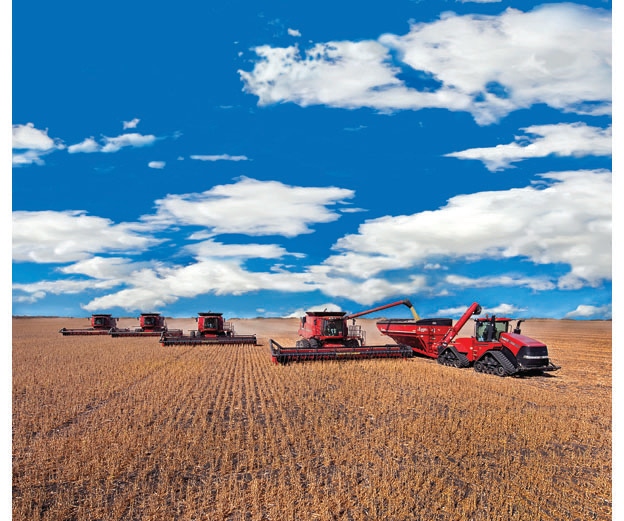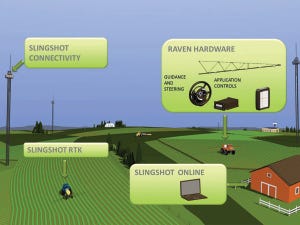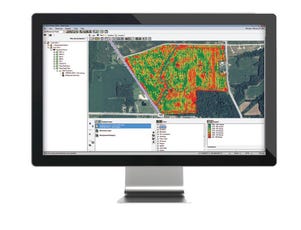February 5, 2013

Cloud-based computing in precision agriculture took a huge leap forward in 2012 and is likely to make another big gain in 2013.
In the past 12 months, options for using “the cloud” to provide wireless connectivity to tractor and combine displays grew dramatically, to the point it is now possible to eliminate the frustration of shuffling thumb drives to keep precision ag data up to date.
The number of cloud-based precision software options that add anytime, anywhere data access increased as well. The software promises streamlined decision making by making information available to key farm management players.
Cloud basics
If talk about cloud computing leaves you scratching your head, you are not alone. For the technology geek crowd, a jargon-laced term like “the cloud” provides a strong hint of what this is all about. But for most of us, not so much.
Wikipedia, the free online encyclopedia, defines “cloud computing” as the use of hardware and software computing resources that are delivered over a network, typically the Internet.
“The analogy I use is the cloud is what enables online banking,” says Paul Welbig, Raven Industries marketing director. Data (your account information) are stored on server computers. To access the data, you fire up a smartphone or tablet computer application or a computer Web browser, then connect via the Internet to view account information.
Given the mobile nature of farming, wireless connectivity — typically through the cellular communication network — is an inseparable component of cloud computing. Other key components include online data storage that boosts information-sharing possibilities, as well as powerful computing resources using online server computers to streamline data analysis.
“Cloud computing can create synergy between farmers, agronomy consultants, retailers, seed companies and other suppliers,” says Trevor Mecham, Case IH Advanced Farming Systems marketing manager. “You are putting a collaborative effort together, through a Web-based service, to share information in real time. That is the holy grail for data management for larger farming operations.”
Connected displays
If wireless connectivity is the core technology behind cloud computing, in-cab displays are the chief targets of the desire to get connected.
“The amount of data flowing to and from farm fields is just unreal,” says Tim Taylor of MapShots, a precision software company. “The industry is very rapidly moving toward wireless transmission of data in real time. Thumb drives will be a thing of the past.”
Here’s a roundup of wireless connectivity options that allow precision ag data to be imported and exported to and from displays. In addition to data transfer options, many systems also include vehicle performance and/or location tracking functions.
 Raven began offering wireless services to compatible Raven displays in 2010, when it introduced its Slingshot (ravenslingshot.com) communications system. Slingshot, which also delivers RTK corrections to Raven receivers and most other receiver brands, uses a 3G cellular data modem to minimize data download times. The Slingshot Field Hub kit, which retails for $2,000, includes access to the Slingshot online network. Access keys for third-party software via Slingshot are $150 to $400 annually.
Raven began offering wireless services to compatible Raven displays in 2010, when it introduced its Slingshot (ravenslingshot.com) communications system. Slingshot, which also delivers RTK corrections to Raven receivers and most other receiver brands, uses a 3G cellular data modem to minimize data download times. The Slingshot Field Hub kit, which retails for $2,000, includes access to the Slingshot online network. Access keys for third-party software via Slingshot are $150 to $400 annually.
Trimble began offering direct connectivity to its FmX and CFX-750 displays in 2010, enabling wireless import and export of precision data, including yield data, as-applied variety maps, drainage designs, guidance lines and prescription maps. The system is available through the Connected Farm service available to Farm Works Software customers. The annual fee for the office-to-field data transfer is $360. A cellular modem, a data service plan and required Farm Works software are additional. Visit connectedfarm.com.
AgIntegrated (agintegrated.com) introduced Onsite, a cloud-based mobile and desktop application, in 2012. The company designed Onsite to solve the challenge of wirelessly transferring precision ag data to displays not currently supporting wireless data transfer. Onsite also provides a single data transfer system for use in mixed-brand farm equipment fleets. It links precision data stored on office computers to Internet servers that automatically download data to smartphones and tablet computers in the field. Data are then wirelessly transferred to a compact flash card or USB thumb drive via Onsite’s Relay data transfer device for manual download to the display. The annual fee per Onsite account is $499, with volume discounts available for multiple accounts. The list price of the OnSite Relay is $345.
The Outback Max (outbackmax.com) integrated display terminal, introduced by Hemisphere GPS in 2012, provides wireless data transfer using the optional ConnX data management system. ConnX connects the in-cab terminal with the farm office and service providers using AgJunction, AgVerdict, NutriScription HD, OptiGro and Precision.Ag data platforms. The ConnX cellular modem also accesses RTK correction signals and provides Internet connectivity for real-time weather and market information via a custom Web browser. The bundled price for the ConnX service, including a terminal unlock, a CDMA cellular modem, a cellular data plan and access to the ConnX website, is $2,695.
John Deere plans to open the wireless information pipeline to and from its GreenStar 2630 display in time for harvest 2013. The company expects more capabilities to be in place by 2014 planting, including import of prescription planting maps and export of as-applied maps to and from major precision ag software programs, says Charles Schleusner, product line marketing manager for My John Deere Solutions (myjohndeere.com).
“We believe in the value of the cloud for John Deere and our customers,” Schleusner says. “We want to remove a hurdle to allowing producers to easily share data with key advisors to help them make profitable decisions.”
To help accomplish that, John Deere, which is collaborating with outside companies to make data transfer seamless, has introduced MyJohnDeere.com, a centralized online portal to access, view, archive and manage business information. Prices for data sharing and advanced features on MyJohnDeere.com are yet to be released. The MyJohnDeere Web portal is available for access today free of charge.
In addition to the GreenStar 3 display 2630, users need a JDLink, which includes the Modular Telematics Gateway (MTG) cellular modem, which has been standard on 8R tractors since 2011 and has been standard on all John Deere large agricultural machines since 2012. My John Deere Solutions are available on other brands equipped with the required GreenStar 3 2630 display and MTG.
Cloud-based precision software
Precision ag software companies have incorporated cloud capabilities ranging from data transfer to online data storage, seamless behind-the-scenes online computing to supplement PC software, and Web-based programs that reside solely on the cloud.
Here’s a look at several cloud-capable precision ag software options.
AgJunction (agjunction.com), which was purchased by Hemisphere GPS in 2012, is a totally cloud-based software program. All data are stored and analyzed on remote server computers and accessed through a Web browser. It is available through service providers such as fertilizer dealers and agronomists, including Wilbur Ellis (AgVerdict), Crop Productions Services (NutriScription HD), Jimmy Sanders (OptiGro) and Precision Ag Consultants (Precision.Ag).
 Farm Works Software (farmworks.com), a division of Trimble, uses the cloud to wirelessly synchronize Farm Works data on office computers and FmX and CFX-750 displays via its Connected Farm (connectedfarm.com) service.
Farm Works Software (farmworks.com), a division of Trimble, uses the cloud to wirelessly synchronize Farm Works data on office computers and FmX and CFX-750 displays via its Connected Farm (connectedfarm.com) service.
MapShots AgStudio (mapshots.com), new to farmers in 2012, is a hybrid office computer and cloud-based program. It stores precision ag data on the cloud, but office computing power is used to analyze data and develop application prescriptions.
FarmRite, from SST Software (sstsoftware.com), has been available to ag retailers and their customers for more than a decade and is a totally cloud/Web-based precision ag program. It is designed to process variable-rate fertility recommendations, yield maps and other analyses and decision-support services.
Cloud decision aids
Two cloud-based nutrient management and variable-rate seeding prescription development services introduced in 2012 hint at a future where sophisticated farm-specific decision aids will be a mouse click away.
United Soils Inc. (unitedsoilsinc.com) designed i-F.A.R.M. to bring sophisticated crop nutrient management tools to any Internet-connected computer. The open-platform program’s tools allow the importation of soil test data from any soil test laboratory, and yield data from major yield monitor brands. Web-based tools then manipulate data to develop downloadable fertilizer prescriptions based on soil fertility, nutrient removal from the previous crop, yield goals, fertilizer prices and other management factors. The i-F.A.R.M. program is available through participating fertilizer dealers, often as part of a service package, or by direct subscription for $400 to $600 annually, plus a per-acre controller file creation fee.
The R7 Tool from Winfield Solutions (winfield.com), the seed and crop protection products arm of Land O’Lakes, harnesses the power of industrial-strength computers and software to bring a Web-based precision planning tool to the farm. The tool, which was rolled out to Winfield retailers in the fall of 2011, allows farmers without extensive yield and grid soil sampling records to get a start in variable-rate seeding and fertility. It crunches data harvested from multiple years of satellite images to identify management zones, assist in building variable-rate seeding and fertilizer prescriptions, and identify top genetics. The R7 Tool is available from Winfield Solutions retailers.
About the Author(s)
You May Also Like






